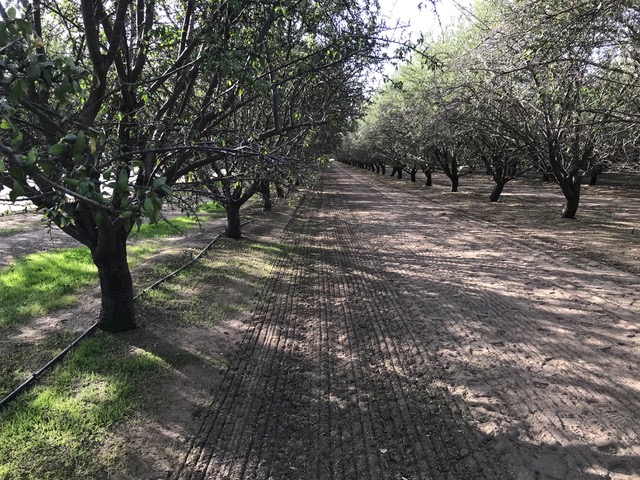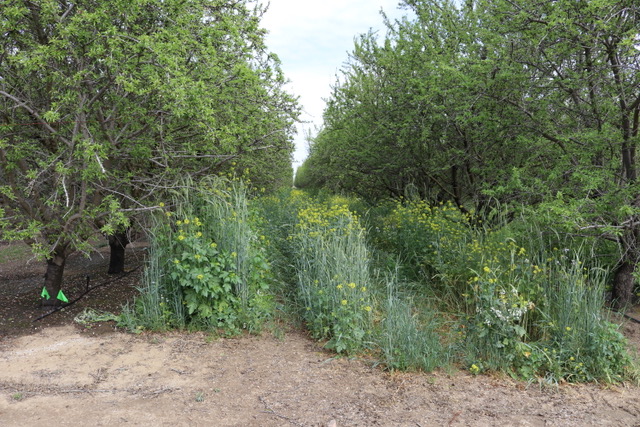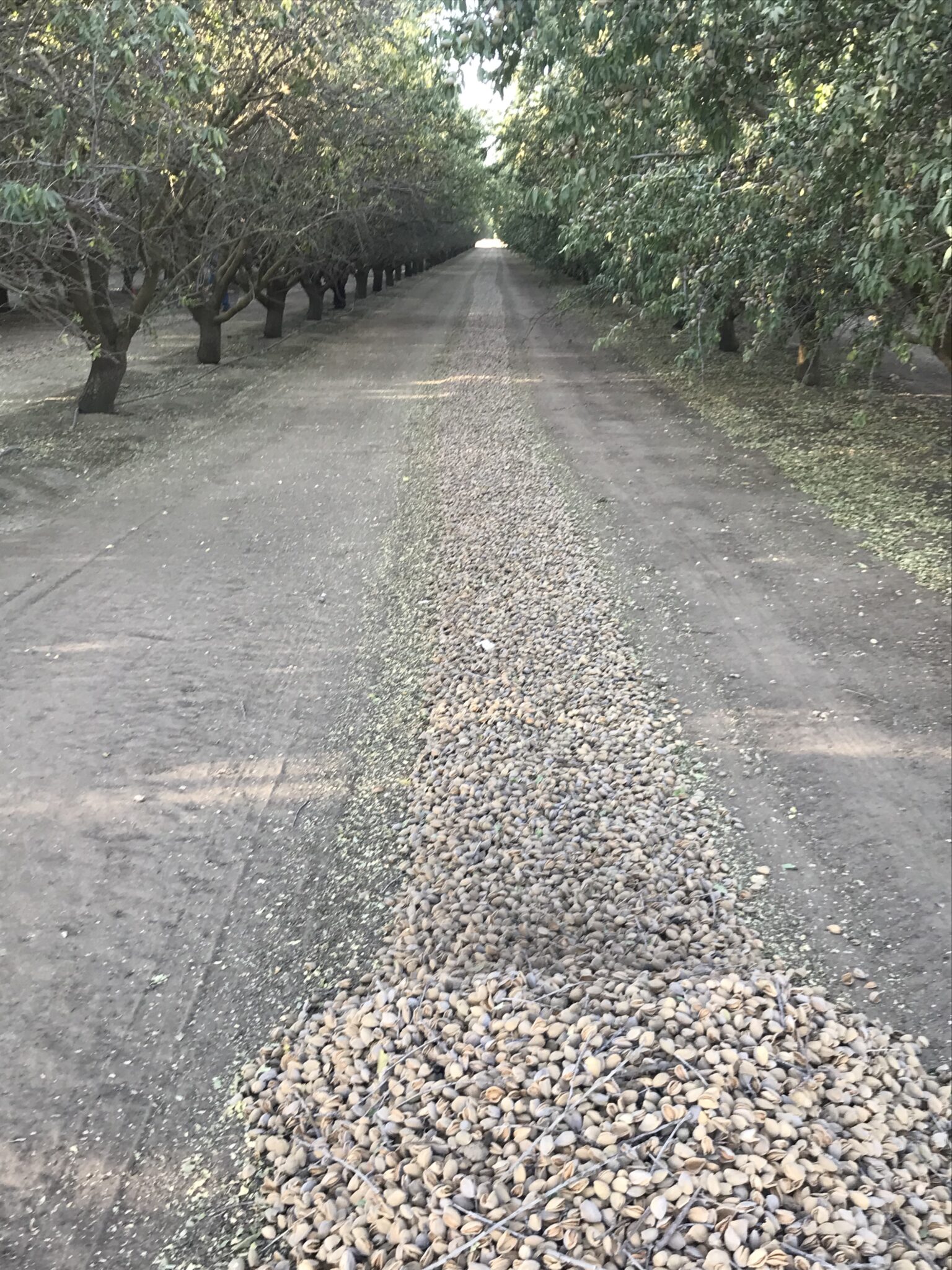
Almond orchard middles are first and foremost considered working surfaces in the orchard. It’s obvious from the language we use to talk about them: the orchard floor, the drive row, etc. But years of keeping middles free of any vegetation can lead to the development of problems in orchard soils, and sacrifices the many benefits that can be gained by having winter vegetation in orchard alleyways.
Winter cover crops hold promise to help growers address multiple production challenges associated with poor soil health and uncertainties in water resources while fostering bee health and sustainability. Despite its potential, this practice is not widely implemented mostly due to concerns regarding water usage, residues at harvest and frost risks in some regions. Successful growers’ experience, and research1 by the University of California, with support from the Almond Board and the California Department of Food and Agriculture, point toward winter cover crops being clearly compatible with large-scale almond production in California. Renewed interest in bee health, incentive programs and widespread soil-related management issues across the Valley have increased demand for information on cover crops. Here, we detail how to get started and considerations to minimize potential production and management constraints.
Why Consider Cover Crops
Cover crops have the potential to tackle multiple management goals. Impacts vary with cover crop mixtures and growth, and a seeded cover crop will likely provide more benefits than resident vegetation. Potential benefits include: 1) improved soil physical properties like infiltration and water holding capacity; 2) increased bee health from improved floral resources; 3) decrease in winter weed pressure; 4) improved orchard access; and 5) increased biological activity and nutrient retention and cycling in the system.
Improvements in soil physical properties are a primary objective for many almond growers. This was a main driver for grower Greg Wegis, who is collaborating with our research in Kern County (see related sidebar.)
“Wegis and Young Property Management considered growing cover crops as a solution to water penetration issues in Arvin,” Wegis said.
So far, he’s been happy with the results, noting, “We definitely notice improved infiltration.”
Cover crop residues and root structures can lower compaction and improve aggregation of soil particles, which, in combination with better infiltration and water holding, could allow for more water storage. Improved infiltration helps with salt leaching to reduce salinity, enables better orchard access and improves efficiency of compost and gypsum applications. Considerable improvements in water infiltration and sodicity can be found after as few as two years of cover crops. Some growers using cover crops have also noticed decreased dust and particle emissions at harvest, but linkages between soil health improvement and air quality remain anecdotal.
Research has also shown that flowering cover crops can support bees by providing habitat and nutrient resources before and during almond bloom. Planting abundant and diverse flowering plants provide pollen and nectar early in the season to mitigate honey bee nutritional stress while providing critical support for wild bee populations preceding and immediately following almond bloom.
Controllable plant covers can compete with and displace weedy vegetation. Fast establishment and growth are critical determinants of weed suppression in the winter and, potentially, later-emerging summer weeds after the cover crop is terminated. Numerous cover crop mixes effectively reduce winter weed populations compared to standard bare soil and herbicide practices.
Cover crops also add organic nutrients to the systems which can broadly and quickly influence soil fertility. Organic sources of nutrients, especially nitrogen, can offset synthetic fertilizer inputs in the spring if release from the cover crop is synchronized with tree demand and residues are placed near the tree roots. Cover crops also provide organic carbon for storage in soil. Yet, increasing soil organic carbon, the building block of healthy soils, is particularly challenging in our climate and soils. Medium- to long-term use of cover crop is necessary to see improvements in soil organic matter levels.
Although the potential of cover crops to improve soil structure and fertility is well known, harnessing shifts in soil communities and their activity to build soil health and control pests remains a challenge. Albeit hard to manage, broadly restoring life into soils is key to enhance soil health, and experiments show that soil communities respond rapidly to cover crops in almond orchards. Live roots in the system can increase the amount and activity of microbes and enrichment of soil food webs. Some cover crops, especially brassicas, can also reduce pest nematode populations.

How to Minimize Potential Problems
The two biggest concerns we hear about using cover crops is competition for water and debris at harvest. Knowledge gathered from a growing community of growers and researchers shows that sound cover crop management can help mitigate water competition and potential interference with harvest.
Water use was certainly on the mind of Wegis. The site where we worked together historically receives about 7 inches of rainfall a year.
“Water was a prime concern,” Wegis recounted. “With help from universities, we documented that there was almost no increase in ET from the overall orchard with winter cover crop vs bare soil. This was the biggest surprise for sure.”
Our research is finding that there is no large or significant difference in water use by the cover crop and water lost to evaporation from bare soil, particularly when increased water infiltration decreases run-off. Fall water use can be minimized by planting just ahead of fall rains. Spring water use can be decreased by earlier termination by mowing and/or herbicide after almond bloom.
To avoid harvest debris, the right species mix and timely termination are critical. In general, legumes decompose faster than grasses and brassicas, and are a useful addition to mixes to lower risks of residues at harvest. In young, bearing orchards that are still filling in, grasses can dominate and get out of hand. Orchards that receive precipitation well into spring, or with micro-sprinklers, have more flexibility to terminate into May, because this water can help with the biomass breakdown. Orchards in drier regions and/or on drip are better suited for April termination timing.
If frost is a risk in your region, consider a low-growing but fast-recovering species (i.e. sub-clover). In general, cover crops buffer heat flow and storage2 in the soil without major impact on temperatures 5 feet above ground, but winter mowing and choosing low stature species can further help reduce risk.
How to Get Started
Cover crop management decisions are guided by the specific features of your orchard and management goals. The following list walks through the steps to getting started with cover crops.
Identify management goals and orchard features: Diagnose your orchard and prioritize your main objectives. How old is your orchard? What are the main challenges you experience that cover crops may help alleviate (e.g. compaction, weed pressure, sodicity?) Answering these questions will help you pick a mix of species based on your goals. The article mentioned in references3 and species selection tool4 can help you think through different cover crop goals and how to best achieve them.
Plan and start small: Gather information, make cover crop management choices and implement a small trial. Fellow growers and managers, seed suppliers, UCCE farm advisors and UCCE Healthy Soils specialists, and NRCS and RCD staff offer lessons and experience. Investment in seedbed preparation, which creates an even surface and good seed-soil contact, is an important step to obtain good stands and harvest conditions. Consider your seeding and mowing equipment in establishing row width to minimize effort and complexities when you get started. Grain drills and no-till drills are usually best at establishing a stand without disturbing the rest of the orchard floor. Some working of the soil ahead of the seeder may be necessary to get started, especially in highly compacted soils. Time your planting to help prevent competition for water while giving the cover crop time for robust growth, and have a plan for termination and potential in-season growth control before you plant the cover crops: will you mow them, or terminate with herbicides? These choices will affect species selection and the magnitude of benefits you might obtain from your ground cover.
3.) Scaling up: Seek incentives programs and map out costs, logistics and systems changes. Look to programs like Seeds for Bees, the CDFA Healthy Soils grants and NRCS EQIP for financial assistance.
A growing body of research indicates that significant challenges lie ahead for agriculture in terms of input use efficiency and resilience to environmental stressors. Winter cover crop remains one of the most accessible strategies for almond growers to withstand and thrive through these stressors by improving soil properties, increasing bee health, decreasing weed pressure, improving nutrient cycling and shifting soil microbial communities. Renewed interest and experimentation are finding these benefits can be gained without sacrificing precious water or causing problems at harvest.

References
1) A summary of research can be found on the Almond Doctor website article: “Cover crop research review: How can it help almonds?”
2) http://www.sacvalleyorchards.com/almonds/horticulture/cover-crops-in-almonds-research-updates/
3) http://www.sacvalleyorchards.com/almonds/horticulture/cover-crop-seed-selection/
4) http://cekern.ucanr.edu/CDFA_Grants/HSP_Grants/Cover_Crop_Selection_Tool/















